 Want to know why some brands connect with consumers more than others on social media?
Want to know why some brands connect with consumers more than others on social media?
Wondering if the tone of your social media marketing is affecting sales?
In this article, you'll find insights from new research that reveal how consumers feel about the content and conversations businesses are serving up on social media.
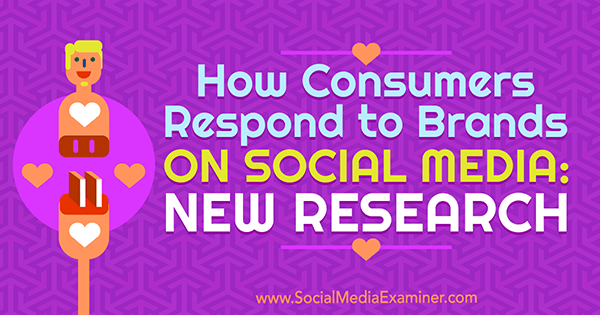
#1: Brand Behavior Affects Consumer Purchase Decisions
It's not only about what types of content you post, according to a recent study by Sprout Social.
For their Q2 2017 Sprout Social Index report titled, Consumers Aren't Looking to Buy From Brands That Are “Cool” on Social, they studied 289,000 public social media profiles and surveyed more than 1,000 consumers and found that nearly half of respondents (48%) want to purchase from brands that are responsive to their customers on social media. This supports the basic premise of social media marketing: It's about the conversations you have with your audience.
Furthermore, 36% of respondents say that when a brand is humorous, they're more likely to buy from them.
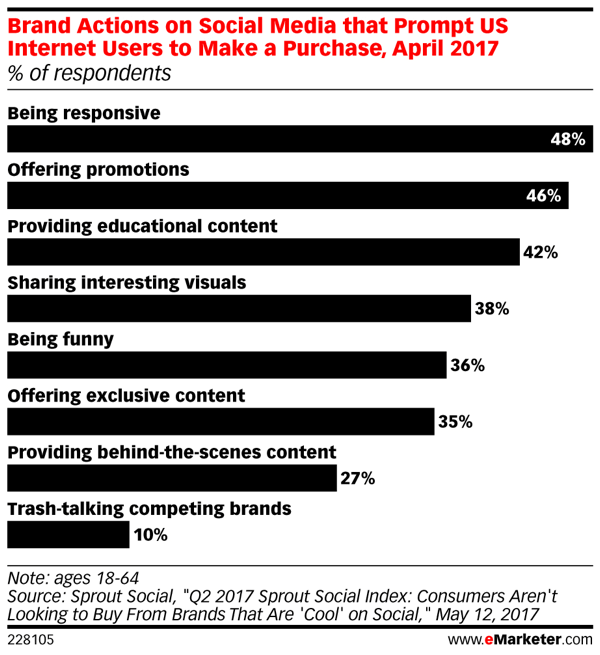
Interestingly, while 67% of respondents say they don't like it when brands make fun of competitors, 10% of people surveyed say that they'll purchase from brands that trash-talk competitors.
In fact, Sprout Social found several things that brands do that their audience dislikes including making fun of customers (88%), talking politics (71%), and using slang (69%).
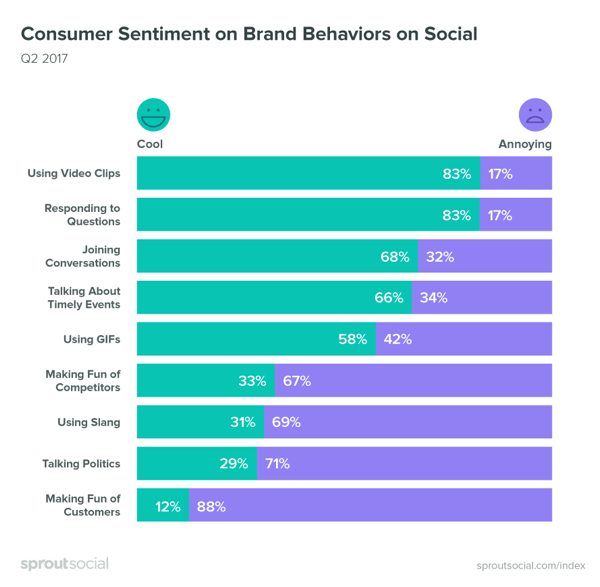
Takeaway
Not surprisingly, audience preferences on the personality a brand projects on social media depends on the platform.
For example, Sprout Social found that 79% of Millennials and 84% of other generations prefer brands to let their personalities shine on Facebook, while 51% of Millennials and 35% of other generations like it on Twitter.
This could have a lot to do with the types of content posted on the respective sites.
On Twitter, brands must be concise and link to other types of content, while on Facebook, the audience can consume much of the content directly on the platform. There's more space to write interesting or funny descriptions on Facebook, allowing for the brand's personality to be communicated better.
Get World-Class Marketing Training — All Year Long!
Are you facing doubt, uncertainty, or overwhelm? The Social Media Marketing Society can help.
Each month, you’ll receive training from trusted marketing experts, covering everything from AI to organic social marketing. When you join, you’ll also get immediate access to:
- A library of 100+ marketing trainings
- A community of like-minded marketers
- Monthly online community meetups
- Relevant news and trends updates

#2: Audiences React Adversely When Brands Cross the Line
There doesn't seem to be a “three strikes and you're out” rule when it comes to how consumers feel about a brand's social media activities.
Sprout Social learned that 51% of respondents will automatically unfollow a brand that does something they dislike, while 27% block them or report them as spam. Just over one-quarter (27%) go as far as to boycott the brand entirely.

Discover Proven Marketing Strategies and Tips
Want to go even deeper with your marketing? Check out the Social Media Marketing Podcast! Publishing weekly since 2012, the Social Media Marketing Podcast helps you navigate the constantly changing marketing jungle, with expert interviews from marketing pros.
But don’t let the name fool you. This show is about a lot more than just social media marketing. With over 600 episodes and millions of downloads each year, this show has been a trusted source for marketers for well over a decade.
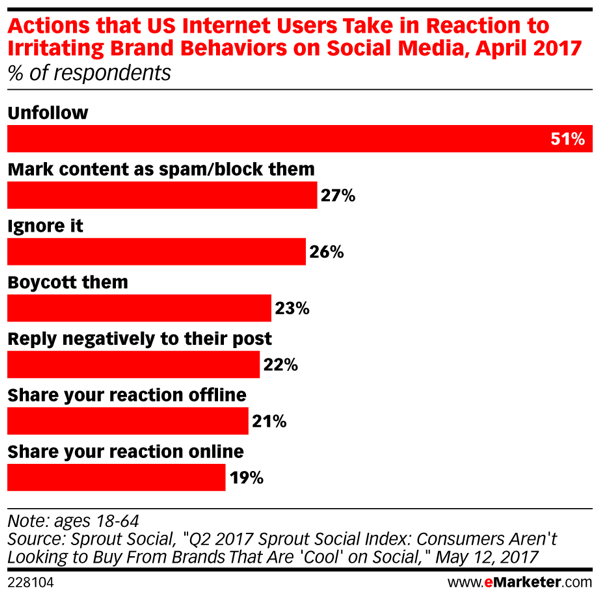
One exception to this is when the brand has an ardent (read: rabid) fan base.
While it's unlikely Apple would post something offensive or make fun of their competitors, their following would probably be more forgiving. That's not to say that everyone would turn a blind eye to something they find offensive, but chances are good that there won't be any massive unfollows or boycotting going on.
Takeaway
A brand will remain in a positive light if they stick with content that supports their brand identity. After all, you'll never find a company mission statement that states the organization's goal as offending as many people online as possible. (If you do know of one that says that, please link in the comments!)
#3: Visual Content That Evokes Strong Emotion Increases Exposure
Social Media Examiner's 2017 Social Media Marketing Industry Report revealed that marketers have the right idea when it comes to the types of content they post: The vast majority use visuals. Eighty-five percent of respondents said they use visual images, while 66% said they blog and 57% report using video content.
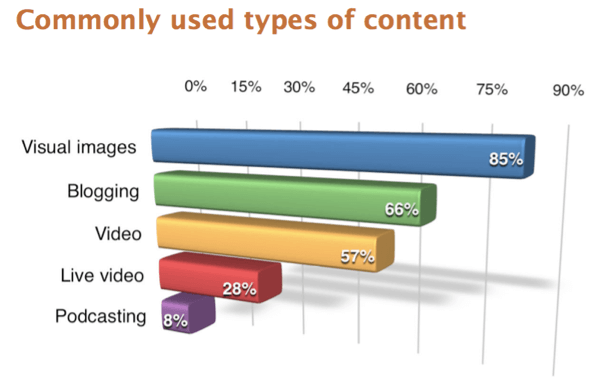
SEOPressor.com, in their article “The Science of Emotion: 4 Keys to Effective Social Media Marketing,” wrote that positive and uplifting content garners more shares than content that's perceived to be sad. Awe-inspiring content does well, too. The idea here is that you want to elicit emotions from your audience… preferably positive ones.
That doesn't mean there isn't a place for content that provokes anger or sadness. Take for example the American Society for the Prevention of Cruelty to Animals (ASPCA) commercial featuring singer Sarah McLachlan singing her hit song “Angel” while a montage of sad images featuring abused and neglected animals plays on screen.
You'd be hard-pressed to find a human being who saw that commercial and felt nothing. In fact, within two years, that commercial was credited with bringing $30 million in donations for the organization.
Takeaway
Showing emotions humanizes brands, and people buy from people. When brands post content that makes people feel something, they're more likely to want to pass that feeling along to their family and friends. There's not a person among us who hasn't pressed the Share button on a meme that features an inspirational saying or a video featuring funny cats doing what cats do.
We want to share that experience, or a cause that we're passionate about, with the people in our lives.
Conclusion
It's important to take a holistic approach to your social media marketing. Human beings are complicated, and a one-size-fits-all approach to posting content doesn't work. Brands should look beyond just posting funny pictures or informational videos. They should consider how the content will make the audience feel and if it will elicit some kind of emotion.
What do you think? What types of social media content and posts work best for your business? Where do you show the most personality? Share your thoughts and questions with us in the comments below.
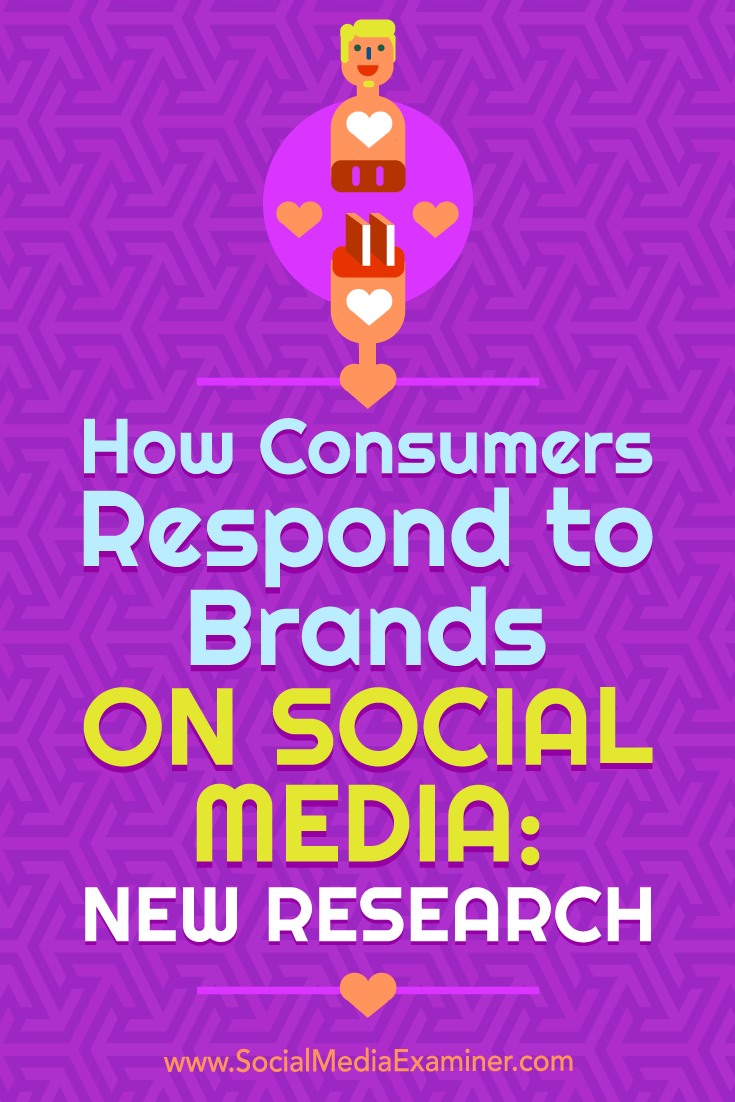
Attention Agency Owners, Brand Marketers, and Consultants

Introducing the Marketing Agency Show–our newest podcast designed to explore the struggles of agency marketers.
Join show host and agency owner, Brooke Sellas, as she interviews agency marketers and digs deep into their biggest challenges. Explore topics like navigating rough economic times, leveraging AI, service diversification, client acquisition, and much more.
Just pull up your favorite podcast app, search for Marketing Agency Show and start listening. Or click the button below for more information.

